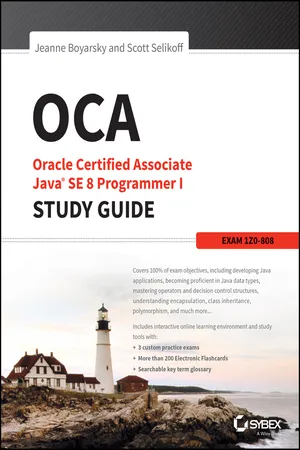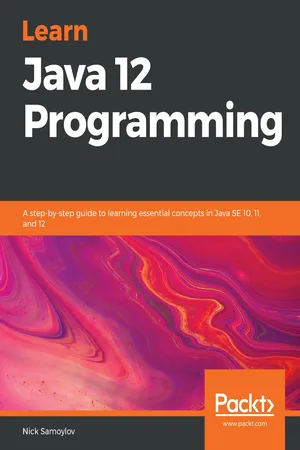Computer Science
Java Method Overriding
Java Method Overriding is a feature in object-oriented programming that allows a subclass to provide a specific implementation of a method that is already provided by its parent class. The method in the subclass must have the same name, parameters, and return type as the method in the parent class. This allows for more flexibility and customization in the behavior of objects.
Written by Perlego with AI-assistance
Related key terms
Related key terms
1 of 4
Related key terms
1 of 3
6 Key excerpts on "Java Method Overriding"
- eBook - ePub
Java Fundamentals
A fast-paced and pragmatic introduction to one of the world's most popular programming languages
- Gazihan Alankus, Rogério Theodoro de Brito, Basheer Ahamed Fazal, Vinicius Isola, Miles Obare(Authors)
- 2019(Publication Date)
- Packt Publishing(Publisher)
Student class:public class Student extends Person { …. public void walk(int speed){ //Walk to class System.out.println("Walking to class .."); } …... }When we call student.walk(20) , this method in our Student class will be called instead of the same method in the Person class. That is, we have provided a unique way to walk for our Student class that isn't the same for the Lecturer and Person classes.In Java, we refer to such a method as overridden and the process as method overriding. The Java virtual machine (JVM) calls the appropriate method for the object that is referred.The Difference between Overriding and Overloading
Let's have a look at the difference between method overloading and overriding:- Method overloading deals with the notion of having two or more methods in the same class with the same name but different arguments:void foo(int a) void foo(int a, float b)
- Method overriding means having two methods with the same arguments, but different implementations. One of them would exist in the parent class, while another would exist in the child class:class Parent { void foo(double d) { // do something } } class Child extends Parent { void foo(double d){ // this method is overridden. } }
Annotations
We will now cover another important topic that will help us write better Java programs.Annotations are a way in which we can add metadata to our programs. This metadata can include information such as the version of a class we are developing. This is useful in scenarios where a class is deprecated or where we are overriding a certain method. Such metadata is not part of the program itself, but can help us catch errors or offer guidance. Annotations have no direct effect on the operation of the code they annotate.Let's look at a scenario. How do we ensure that we are overriding a certain method and not creating another completely different method? When overriding a method, a single mistake such as using a different return type will cause the method to not be overridden anymore. Such a mistake is easy to make but can lead to software bugs later on if not taken care of early in the software development stages. How, then, do we enforce overriding? The answer, as you might have already guessed, is using annotations. - eBook - ePub
IT Interview Guide for Freshers
Crack your IT interview with confidence
- Sameer S Paradkar(Author)
- 2019(Publication Date)
- BPB Publications(Publisher)
Delegation is an alternative to inheritance. Delegation means that you can include an instance of another class as an instance variable and forward messages to the instance. It is often safer than inheritance because it forces you to think about each message you forward because the instance is of a known class, rather than a new class. Because it doesn't force you to accept all the methods of the super class, you can provide only the methods that really make sense. On the other hand, it makes you write more code, and it is harder to reuse (because it is not a subclass).Does Java support multiple inheritances?
Java doesn't support multiple inheritance. Java leverages primitive data types and hence, it is not a pure object-oriented language.What is difference between method overriding and overloading? What restrictions are placed on method overriding?
Overriding is a method with the same name and arguments as the parent, whereas overloading is a method with the same method name but different arguments. Overridden methods must have the same name, argument list, and return types.The overriding method may not limit the access of the method it overrides. The overriding method may not throw any exceptions that may not be thrown by the overridden method. A method cannot be overridden based on different return types and same arguments, as the methods can be called without leveraging their return type in which case it will be ambiguous for the compiler.Does a class inherit the constructors of its superclass?
A class does not inherit constructors from its superclasses.Which object-oriented concept is realized by leveraging overriding and overloading?
Polymorphism is realized through OOPs concepts of overriding and overloadingHow to prevent a class from being inherited?
Declaring the class as final prevents it from being inherited by subclass(es). You can't define a class as final if it is already an abstract class. A class declared as final can't be extended by other classes.Can a class be declared as protected?
A protected specifier cannot be leveraged for classes and interfaces. Fields and methods can be declared as protected in a class. However, fields and methods in an interface can’t be declared as protected. A protected method can be accessed by classes within the same package or by the subclasses of the class in other packages. - eBook - ePub
- Jeanne Boyarsky, Scott Selikoff(Authors)
- 2014(Publication Date)
- Sybex(Publisher)
Wolf method since it would think you were executing a recursive call. A recursive function is one that calls itself as part of execution, and it is common in programming. A recursive function must have a termination condition. In this example, there is no termination condition; therefore, the application will attempt to call itself infinitely and produce a stack overflow error at runtime.Overriding a method is not without limitations, though. The compiler performs the following checks when you override a nonprivate method:- The method in the child class must have the same signature as the method in the parent class.
- The method in the child class must be at least as accessible or more accessible than the method in the parent class.
- The method in the child class may not throw a checked exception that is new or broader than the class of any exception thrown in the parent class method.
- If the method returns a value, it must be the same or a subclass of the method in the parent class, known as covariant return types.
The first rule of overriding a method is somewhat self-explanatory. If two methods have the same name but different signatures, the methods are overloaded, not overridden. As you may recall from our discussion of overloaded methods in Chapter 4, the methods are unrelated to each other and do not share any properties.Overloading vs. Overriding
Overloading a method and overriding a method are similar in that they both involve redefining a method using the same name. They differ in that an overloaded method will use a different signature than an overridden method. This distinction allows overloaded methods a great deal more freedom in syntax than an overridden method would have. For example, take a look at the following code sample: - eBook - ePub
- Nick Samoylov(Author)
- 2022(Publication Date)
- Packt Publishing(Publisher)
superclass .Another form of relationship was defined between classes and interfaces – a class can implement an interface. Since an interface describes how you can interact with an object but not how an object responds to the interaction, different objects can behave differently while implementing the same interface.In Java, a class can have only one direct parent but can implement many interfaces.The ability to behave like any of its ancestors and adhere to multiple interfaces is called polymorphism .In this chapter, we will look at these OOP concepts and how they are implemented in Java. The topics discussed include the following:- OOP concepts
- Class
- Interface
- Overloading, overriding, and hiding
- The final variable, method, and class
- Record and sealed classes
- Polymorphism in action
Technical requirements
To be able to execute the code examples provided in this chapter, you will need the following:- A computer with a Microsoft Windows, Apple macOS, or Linux operating system
- Java SE version 17 or later
- An IDE or code editor that you prefer
The instructions for how to set up a Java SE and IntelliJ IDEA editor were provided in Chapter 1 , Getting Started with Java 17 , of this book. The files with the code examples for this chapter are available in the GitHub repository at https://github.com/PacktPublishing/Learn-Java-17-Programming.git in the examples/src/main/java/com/packt/learnjava/ch02_oop - eBook - ePub
Learn Java 12 Programming
A step-by-step guide to learning essential concepts in Java SE 10, 11, and 12
- Nick Samoylov(Author)
- 2019(Publication Date)
- Packt Publishing(Publisher)
implement an interface. Since an interface describes how you can interact with an object, but not how an object responds to the interaction, different objects can behave differently while implementing the same interface.In Java, a class can have only one direct parent but can implement many interfaces. The ability to behave as any of its ancestors and adhere to multiple interfaces is called polymorphism .In this chapter, we will look at these OOP concepts and how they are implemented in Java. The topics discussed include the following:- OOP concepts
- Class
- Interface
- Overloading, overriding, and hiding
- Final variable, method, and class
- Polymorphism in action
Passage contains an image
OOP concepts
As we have already stated in the introduction, the main OOP concepts are as follows:- Object/Class : It defines a state (data) and behavior (methods) and holds them together
- Inheritance : It propagates behavior down the chain of classes connected via parent-child relationships
- Abstraction/Interface : It describes how the object data and behavior can be accessed. It isolates (abstracts) an object's appearance from its implementations (behavior)
- Encapsulation : It hides the state and details of the implementation
- Polymorphism : It allows an object to assume an appearance of implemented interfaces and behave as any of the ancestor classes
Passage contains an image
Object/class
In principle, you can create a very powerful application with minimal usage of classes and objects. It became even easier to do this after functional programming was added to Java 8, to JDK, which allowed you to pass around behavior as a function. Yet passing data (state) still requires classes/objects. This means that the position of Java as an OOP language remains intact.A class defines the types of all internal object properties that hold the object state. A class also defines object behavior expressed by the code of the methods. It is possible to have a class/object without a state or without a behavior. Java also has a provision for making the behavior accessible statically—without creating an object. But these possibilities are no more than just additions to the object/class concept that was introduced for keeping the state and behavior together. - No longer available |Learn more
- Roselyn Teukolsky(Author)
- 2023(Publication Date)
- Barrons Educational Services(Publisher)
UnderGrad .Polymorphism is the mechanism of selecting the appropriate method for a particular object in a class hierarchy. The correct method is chosen because, in Java, method calls are always determined by the type of the actual object, not the type of the object reference. For example, even though s, g , and u are all declared as type Student, s.computeGrade(), g.computeGrade() , and u.computeGrade() will all perform the correct operations for their particular instances. In Java, the selection of the correct method occurs during the run of the program.Here is a simple example. Now consider this hierarchy of classes, and the declarations that follow it:Suppose the Dog class has this method:public void eat() { /* implementation not shown */ }And each of the subclasses, Poodle, PitBull, Dachshund , etc., has a different, overridden eat method. Now suppose that allDogs is an ArrayList<Dog> where each Dog declared above has been added to the list. Each Dog in the list will be processed to eat by the following lines of code:Polymorphism is the process of selecting the correct eat method, during run time, for each of the different dogs.Recall that constructors are not inherited, and if you use the keyword super in writing a constructor for your subclass, the line containing it should precede any other code in the constructor.Recall also that if the superclass does not have a no-argument constructor, then you must write an explicit constructor for the subclass. If you don’t do this, later code that tries to create a subclass object will get a compile-time error. This is because the compiler will generate a default constructor for the subclass that tries to invoke the no-argument constructor of the superclass.Dynamic Binding (Late Binding)
Making a run-time decision about which instance method to call is known as dynamic binding or late binding. Contrast this with selecting the correct method when methods are overloaded (see p. 106 ) rather than overridden. The compiler selects the correct overloaded method at compile time by comparing the methods’ signatures. This is known as static binding, or early binding. In polymorphism, the actual method that will be called is not determined by the compiler. Think of it this way: The compiler determines if a method can be called (i.e., does the method exist in the class of the reference?), while the run-time environment determines how
Index pages curate the most relevant extracts from our library of academic textbooks. They’ve been created using an in-house natural language model (NLM), each adding context and meaning to key research topics.
Explore more topic indexes
Explore more topic indexes
1 of 6
Explore more topic indexes
1 of 4





